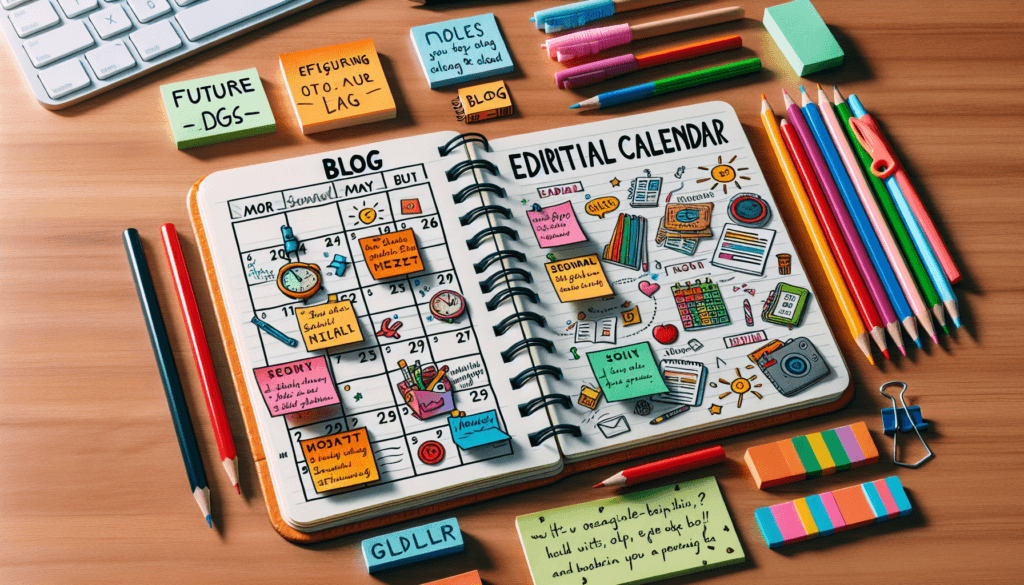If you’re a blogger looking to effectively organize and plan your content, creating a successful blog editorial calendar is essential. This article will guide you through the process of creating a well-structured calendar that will help you stay on track, maintain consistency, and ultimately increase your blog’s success. By following these simple steps, you’ll be able to streamline your content creation process and ensure that you always have engaging and valuable posts ready to go. So, let’s dive in and discover how to create a blog editorial calendar that sets you up for success!

Choose your blogging platform
When starting a blog, one of the first decisions you need to make is which blogging platform to use. With so many options available, it’s important to consider your purpose and evaluate different platforms before making a final decision. The blogging platform you choose will greatly impact the success and functionality of your blog, so take the time to choose wisely.
Consider your purpose
Before you select a blogging platform, it’s essential to clarify your purpose. Are you starting a personal blog to share your thoughts and experiences? Or are you creating a professional blog to showcase your expertise and attract clients? Understanding your purpose will help you determine the features and design elements that are most important to you.
Evaluate different platforms
Once you’ve established your purpose, it’s time to evaluate different blogging platforms. Popular options include WordPress, Blogger, and Squarespace, among others. Each platform has its own strengths and weaknesses, so it’s important to assess which one aligns best with your needs. Consider factors such as ease of use, customization options, available plugins, and community support.
Choose the best platform for your needs
After considering your purpose and evaluating different platforms, it’s time to choose the best one for your needs. It’s crucial to select a platform that aligns with your goals and provides the functionality you desire. Remember that your blogging platform is the foundation of your blog, so make sure it’s a solid one that will support your growth and success.
Determine your blog’s content categories
Once you’ve chosen a blogging platform, it’s time to determine the content categories for your blog. This step is essential for organizing your blog posts and providing structure for your readers.
Identify your target audience
Before you can establish content categories, it’s important to identify your target audience. Who do you want to reach with your blog? Understanding your audience’s interests and needs will help you create relevant and engaging content. Consider demographics, interests, and pain points when defining your target audience.
Brainstorm content categories
Once you have a clear understanding of your target audience, it’s time to brainstorm content categories. These categories should align with your audience’s interests and cover a wide range of topics within your niche. Think about the main themes or topics that your blog will cover and create categories accordingly.
Categorize your blog topics
After brainstorming content categories, it’s time to categorize your blog topics. This step helps you stay organized and ensures that your content is easily accessible to your readers. Assign each blog post to a specific content category to make it easier for your audience to navigate and find relevant content.

Define your blog’s goals and objectives
Before you dive into creating content, it’s crucial to define your blog’s goals and objectives. This step will guide your content creation strategy and help you measure your success.
Set realistic goals
When setting goals, it’s important to be realistic. Consider what you want to achieve with your blog in terms of metrics, such as traffic, engagement, or conversions. Setting attainable goals will give you something to strive for and help you stay motivated.
Establish measurable objectives
In addition to setting goals, it’s vital to establish measurable objectives. These are specific milestones or targets that you can track and evaluate. For example, if your goal is to increase blog traffic, an objective could be to achieve a certain number of monthly page views within a specified timeframe.
Align goals with your blog’s purpose
Lastly, make sure that your goals and objectives align with your blog’s purpose. Keeping your purpose in mind will help you stay focused and ensure that your efforts are in line with what you want to achieve with your blog.
Develop a content creation strategy
With your goals and objectives defined, it’s time to develop a content creation strategy. This strategy will guide your editorial process and help you consistently produce high-quality content.
Create an editorial mission statement
Start by creating an editorial mission statement. This statement should clearly define the purpose of your content and the value it provides to your audience. It serves as a guiding principle for your content creation efforts and helps you stay on track.
Define your content types
Next, define the specific types of content you will create. This could include articles, how-to guides, case studies, interviews, or any other format that aligns with your blog’s purpose and resonates with your audience. By defining your content types, you can ensure a diverse and engaging content mix.
Establish a content creation process
To ensure a consistent and efficient content creation process, establish a clear workflow. Define who will be responsible for each stage of the process, from idea generation to writing, editing, and publishing. Having a well-defined process in place will help you stay organized and avoid any bottlenecks or delays.

Research and identify blog post ideas
Once you have a solid content creation strategy in place, it’s time to research and identify blog post ideas. This step is crucial for creating valuable and engaging content that resonates with your audience.
Conduct keyword research
Keyword research is an essential part of the ideation process. It helps you identify the topics and keywords that are relevant to your niche and have a high search volume. Use tools like Google Keyword Planner or SEMrush to discover popular keywords and phrases that can inspire your blog post ideas.
Explore competitor’s blogs
Another great source of inspiration is your competitors’ blogs. Take the time to explore what topics they are covering and how they are approaching them. This can help you identify content gaps or find unique angles that haven’t been covered yet. However, make sure to put your own spin on the content to make it unique and valuable to your audience.
Use social listening tools
Social listening tools can also provide valuable insights into the interests and needs of your target audience. Monitor discussions and conversations happening on social media platforms to identify trending topics, pain points, or questions that your audience is asking. This can help you create content that addresses their specific needs.
Plan your blog’s content calendar
Now that you have a pool of blog post ideas, it’s time to plan your blog’s content calendar. This calendar will ensure that you consistently produce and publish content that aligns with your goals and objectives.
Determine your publishing frequency
Consider how often you want to publish new content on your blog. This will depend on various factors, including your available resources and the expectations of your target audience. Decide on a realistic publishing frequency that you can maintain consistently.
Plot important dates and events
Take into account any important dates or events that are relevant to your niche. These could be holidays, industry conferences, or product launches, for example. Plotting them on your calendar will help you plan timely and relevant content.
Allocate content ideas to specific dates
Once you have determined your publishing frequency and identified important dates, allocate your content ideas to specific dates on your content calendar. This will help you stay organized and ensure a consistent flow of content. Assign each blog post idea to a specific date and adjust as needed.

Manage and organize your blog content
To effectively manage and organize your blog content, it’s important to use a content management system (CMS), create a content repository, and establish a content review process.
Use a content management system
A CMS is a software or platform that allows you to create, edit, and publish content on your website. It provides a user-friendly interface and essential features for managing your blog. Popular CMS options include WordPress, Drupal, and Joomla, among others.
Create a content repository
A content repository is a centralized location where you can store and organize your blog content. This could be a folder on your computer, a cloud-based storage system, or a project management tool. Having a content repository makes it easy to access and manage your content, especially if you have multiple team members working on your blog.
Establish a content review process
A content review process ensures that your blog posts go through a thorough review before being published. This includes checking for grammar and spelling errors, verifying facts, and ensuring that the content aligns with your brand guidelines. Assign specific team members or editors to review each blog post and set clear deadlines for feedback and revisions.
Assign responsibilities and deadlines
To effectively manage your blog and ensure that tasks are completed on time, it’s important to assign responsibilities and set deadlines for each task.
Identify key team members
If you have a team working on your blog, identify key team members and their roles. This could include writers, editors, designers, and social media managers, among others. Clearly define their responsibilities and ensure that everyone understands their role in the content creation process.
Delegate tasks and responsibilities
Once you have identified your team members and their roles, delegate tasks and responsibilities accordingly. Make sure that each task is assigned to the most suitable team member based on their skills and expertise. Clear communication and expectations are key to ensuring that tasks are completed successfully.
Set deadlines for each task
To keep your content creation process on track, set deadlines for each task. This includes deadlines for topic ideation, first drafts, revisions, and final publication. Be realistic with your deadlines and ensure that everyone is aware of the timeline. Consider using project management tools or task management software to keep track of deadlines and progress.

Track and analyze your blog performance
Tracking and analyzing your blog’s performance is essential for evaluating your progress and making informed decisions to improve your strategy.
Set up analytics tools
Set up analytics tools, such as Google Analytics, to track key performance indicators (KPIs) for your blog. This will provide valuable insights on metrics like website traffic, bounce rate, time on page, and conversion rates. Regularly review these analytics to understand how your content is performing and identify areas for improvement.
Monitor key performance indicators
Identify the key performance indicators (KPIs) that are most relevant to your blog’s goals and objectives. These could include metrics like pageviews, social shares, email subscribers, or revenue generated. Continuously monitor and evaluate these metrics to measure the success of your blog and identify areas for optimization.
Analyze and adjust your strategy accordingly
Based on the data and insights gathered from your analytics, analyze and adjust your content creation strategy accordingly. Identify what is working well and replicate those successes in future blog posts. Also, pinpoint any areas that need improvement and consider making adjustments to your strategy. Data-driven decisions will help drive the success and growth of your blog.
Continuously update and optimize your calendar
Creating a successful blog editorial calendar is an ongoing process. To maximize its effectiveness, it’s important to continuously review and optimize your calendar.
Review and revise your calendar regularly
Regularly review and revise your editorial calendar to ensure that it remains relevant and aligned with your goals. Remove any outdated or irrelevant topics and replace them with new, fresh ideas. Additionally, assess whether your current publishing frequency is sustainable and make adjustments as needed.
Incorporate new ideas and trends
As you continue to generate new ideas and stay informed about industry trends, incorporate them into your editorial calendar. Flexibility and adaptability are key to keeping your content fresh and engaging. Stay on top of emerging topics and trends to provide value to your audience and differentiate yourself from competitors.
Make necessary adjustments to your strategy
Periodically assess your overall content creation strategy and make necessary adjustments as your blog grows and evolves. This could include changes to your target audience, content types, or distribution channels. Stay open to experimentation and be willing to pivot your strategy when necessary. The ability to adapt is crucial for long-term success.
In conclusion, creating a successful blog editorial calendar requires careful planning, organization, and a deep understanding of your audience and goals. By choosing the right blogging platform, defining your content categories, setting goals and objectives, developing a content creation strategy, conducting thorough research, planning your content calendar, managing and organizing your content, assigning responsibilities and deadlines, tracking and analyzing your performance, and continuously updating and optimizing your calendar, you can create a blog that resonates with your audience and achieves your desired results. Happy blogging!


